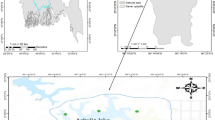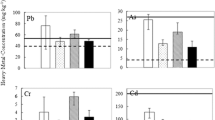Abstract
Dietary uptake of heavy metals through the consumption of vegetables grown on polluted soil can have serious human health implications. Thus, the study presented in this paper investigated the bioaccumulation and associated dietary risks of Pb, Zn, and Cd present in vegetables widely consumed in Nigeria, namely amaranth and jute mallow, grown on soil irrigated with polluted water from Asa River. The study found that the soil was polluted with Zn, Pb, and Cd with Pb and Cd being contributed by polluted river, while Zn was from geogenic sources. The metal concentration in amaranth and jute mallow varied in the order of Zn > Pb > Cd and Zn > Pb ≈ Cd, respectively. Jute mallow acts as an excluder plant for Pb, Cd, and Zn. Consequently, the metal concentrations in jute mallow were below the toxic threshold levels. Furthermore, non-cancer human health risk of consuming jute mallow from the study site was not significant. In contrast, the concentrations of Pb and Cd in amaranth were found to be above the recommended safe levels and to be posing human health risks. Therefore, further investigation was undertaken to identify the pathways of heavy metals to amaranth. The study found that the primary uptake pathway of Pb and Cd by amaranth is foliar route, while root uptake is the predominant pathway of Zn in amaranth.



Similar content being viewed by others
References
Abdu, N., Abdulkadir, A., Agbenin, J. O., & Buerkert, A. (2011). Vertical distribution of heavy metals in wastewater- irrigated vegetable garden soils of three West African cities. Nutrient Cycling in Agroecosystems, 89, 387–397.
Adah, C. A., Abah, J., Ubwa, S. T., & Ekele, S. (2013). Soil availability and uptake of some heavy metals by three staple vegetables commonly cultivated along the south bank of River Benue, Makurdi, Nigeria. International Journal of Environment and Bioenergy, 8, 56–67.
Cui, Y. J., Zhu, Y. G., Zhai, R. H., Chen, D. Y., Huang, Y. Z., Qui, Y., & Liang, J. Z. (2004). Transfer of metals from near a smelter in Nanning, China. Environment International, 30, 785–791.
Fatoba, P. O., Adepoju, A. O., & Okewole, G. A. (2012). Heavy metal accumulation in the fruits of tomato and okra irrigated with industrial waste effluents. Journal of Industrial Pollution Control, 28(2), 103–107.
Gupta, N., Khan, D. K., & Santra, S. G. (2012). Heavy metal accumulation in vegetables grown in a long-term wastewater-irrigated agricultural land of tropical India. Environmental Monitoring and Assessment, 184(11), 6673–6682.
Hallenbeck, W. H. (1993). Quantitative risk assessment for environmental and occupational health. Chelsea: Lewis publications.
Ibrahim, K. O., Okunlola, I. A., & Abdurrahman, A. (2013). Trace metal indices in the characterization of hydrogeochemical condition of surface water along Asa River, Ilorn, Kwara State, Nigeria. International Journal of Geology, Earth and Environmental Science, 3(1), 29–35.
Islam, E., Yang, X., He, Z., & Mahmood, Q. (2007). Assessing potential dietary toxicity of heavy metals in selected vegetables and food crops. Journal of Zhejiang University (Science), 8(1), 1–13.
Kabata-Pendias, A., & Mukherjeee, A. (2007). Trace elements from soil to human. Heidelberg: Springer.
Lanre-Iyanda, T. Y., & Adekunle, I. M. (2012). Assessment of heavy metals and their estimated daily intakes from two commonly consumed foods ound in Nigeria. African Journal of Food Agriculture Nutrition and Development, 12(3), 6156–6169.
Ogunkunle, C. O., Fatoba, P. O., Awotoye, O. O., & Olorunmaiye, K. S. (2013). Root-shoot partitioning of Cu, Cr and Zn in Lycopersicum esculentum and Amaranthus hybridus grown in cement-polluted soil. Environmental and Experimental Biology, 11, 131–136.
Oluwatosin, G. A., Adeoyolanu, A. O., Ojo, A. O., Are, K. S., Dauda, T. O., & Aduramigba-Modupe, V. O. (2010). Heavy metal uptake and accumulation by edible leafy vegetable (Amaranthus hybridus) grown on urban valley bottom soils in southwestern Nigeria. Soil and Sediment Contamination, 19, 1–20.
Orisakwe, O. E., Kanayochukwu, N. D., Nwadiuto, A. C., Daniel, D., & Onyinyechi, O. (2012). Evaluation of potential dietary toxicity of heavy metals of vegetables. Environmental and Analytical Toxicology. doi:10.4172/2161-0525.1000136.
Pinto, A. P., Mota, A. M., De Varennes, A., & Pinto, F. C. (2004). Influence of organic matter on the uptake of cadmium, zinc, copper and iron by sorghum plants. Science of the Total Environment, 326, 239–247.
Rattan, R. K., Datta, S. P., Chhonkar, P. K., Suribabu, K., & Singh, A. K. (2005). Long-term impact of irrigation with sewage effluents on heavy metal content in soils, crops and groundwater-a case study. Agriculture, Ecosystems and Environment, 109, 310–322.
Reddy, K. R., Hettiarachci, H., Gangathulasi, J., Bogner, J. E., & Lagier, T. (2009). Geotechnical properties of synthetic municipal solid waste. International Journal of Geotechnical Engineering, 3(2), 429–438.
Ruel, M. T., Minot, N. & Smith, L. (2004). Patterns and determinants of fruit and vegetable consumption in sub-Saharan Africa. Background paper for the Joint FAO/WHO Workshop on Fruit and vegetables for Health, 1-3 September, Kobe Japan.
Singh, A., Sharma, R. K., Agrawal, M., & Marshall, F. M. (2010). Health risk assessment of heavy metals via dietary intake of foodstuffs from the wastewater irrigated site of a dry tropical area in India. Food and Chemical Toxicology, 48, 611–619.
Taylor, S. R., & McLennan, S. M. (1985). The continental crust: its composition and evolution. Oxford: Blackwell.
USEPA (U.S. Environmental Protection Agency) (2002). Region 9, preliminary remediation goals. http://www.epa.gov/region09/waste/sfund/prg. Accessed 21 December 2013.
Vasiliadou, S., & Dordas, C. (2009). Increased concentration of soil cadmium affects on plant growth, dry matter accumulation, Cd, and Zn uptake of different tobacco cultivars (Nicotiana tabacum L.). International Journal of Phytoremediation, 11(2), 115–130.
WHO (World Health Organization). (1996). Trace elements in human nutrition and health. Geneva: World Health Organization.
Zheng, N., Wang, Q. C., & Zheng, D. M. (2007). Health risk of Hg, Pb, Cd, Zn, and Cu to the inhabitants around Huludao zinc plant in China via consumption of vegetables. Science of the Total Environment, 383(1–3), 81–89.
Conflict of interest
The authors declare that this study was not funded by any external agency and they have no conflict of interest.
Author information
Authors and Affiliations
Corresponding author
Rights and permissions
About this article
Cite this article
Ogunkunle, C.O., Ziyath, A.M., Adewumi, F.E. et al. Bioaccumulation and associated dietary risks of Pb, Cd, and Zn in amaranth (Amaranthus cruentus) and jute mallow (Corchorus olitorius) grown on soil irrigated using polluted water from Asa River, Nigeria. Environ Monit Assess 187, 281 (2015). https://doi.org/10.1007/s10661-015-4441-6
Received:
Accepted:
Published:
DOI: https://doi.org/10.1007/s10661-015-4441-6




